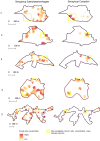This is a preprint.
Factors associated with differential seropositivity to Leptospira interrogans and Leptospira kirschneri in a high transmission urban setting for leptospirosis in Brazil
- PMID: 37090569
- PMCID: PMC10120806
- DOI: 10.1101/2023.04.10.23288388
Factors associated with differential seropositivity to Leptospira interrogans and Leptospira kirschneri in a high transmission urban setting for leptospirosis in Brazil
Update in
-
Factors associated with differential seropositivity to Leptospira interrogans and Leptospira kirschneri in a high transmission urban setting for leptospirosis in Brazil.PLoS Negl Trop Dis. 2024 May 17;18(5):e0011292. doi: 10.1371/journal.pntd.0011292. eCollection 2024 May. PLoS Negl Trop Dis. 2024. PMID: 38758957 Free PMC article.
Abstract
Background: Leptospirosis is a zoonosis caused by pathogenic species of bacteria belonging to the genus Leptospira. Most studies infer the epidemiological patterns of a single serogroup or aggregate all serogroups to estimate overall seropositivity, thus not exploring the risks of exposure to distinct serogroups. The present study aims to delineate the demographic, socioeconomic and environmental factors associated with seropositivity of Leptospira serogroup Icterohaemorraghiae and serogroup Cynopteri in an urban high transmission setting for leptospirosis in Brazil.
Methods/principal findings: We performed a cross-sectional serological study in five urban informal communities in the city of Salvador, Brazil. During the years 2018, 2020 2021, we recruited 2.808 residents and collected blood samples for serological analysis using microagglutination assays. We used a mixed-effect multinomial logistic regression model to identify risk factors associated with seropositivity for each serogroup. Seropositivity to Cynopteri increased with age in years (OR 1.03; 95% CI 1.01-1.06) and was higher in those living in houses with unplaster walls (exposed brick) (OR 1.68; 95% CI 1.09-2.59) and where cats were present near the household (OR 2.00; 95% CI 1.03-3.88). Seropositivity to Icterohaemorrhagiae also increased with age in years (OR 1.02; 95% CI 1.01-1.03) but was higher in males (OR 1.51; 95% CI 1.09-2.10), in those with work-related exposures (OR 1.71; 95% CI 1.10-2.66) or who had contact with sewage (OR 1.42; 95% CI 1.00-2.03). Spatial analysis showed differences in distribution of seropositivity to serogroups Icterohaemorrhagiae and Cynopteri within the five districts where study communities were situated.
Conclusions/significance: Our data suggests distinct epidemiological patterns associated with serogroups Icterohaemorrhagiae and Cynopteri within the high-risk urban environment for leptospirosis and with differences of spatial niches. Future studies must identify the different pathogenic serogroups circulating in low-income areas, and further evaluate the potential role of cats in the transmission of the serogroup Cynopteri in urban settings.
Keywords: co-circulation; determinants; leptospirosis; seroprevalence.
Conflict of interest statement
Conflicts of Interest: The authors declare that there is no conflict of interest.
Figures



References
-
- Mcbride AJA, Athanazio DA, Reis MG, Ko AI. Leptospirosis. Trop Travel Dis. 2005;18: 376–386. - PubMed
Publication types
Grants and funding
LinkOut - more resources
Full Text Sources
Miscellaneous
